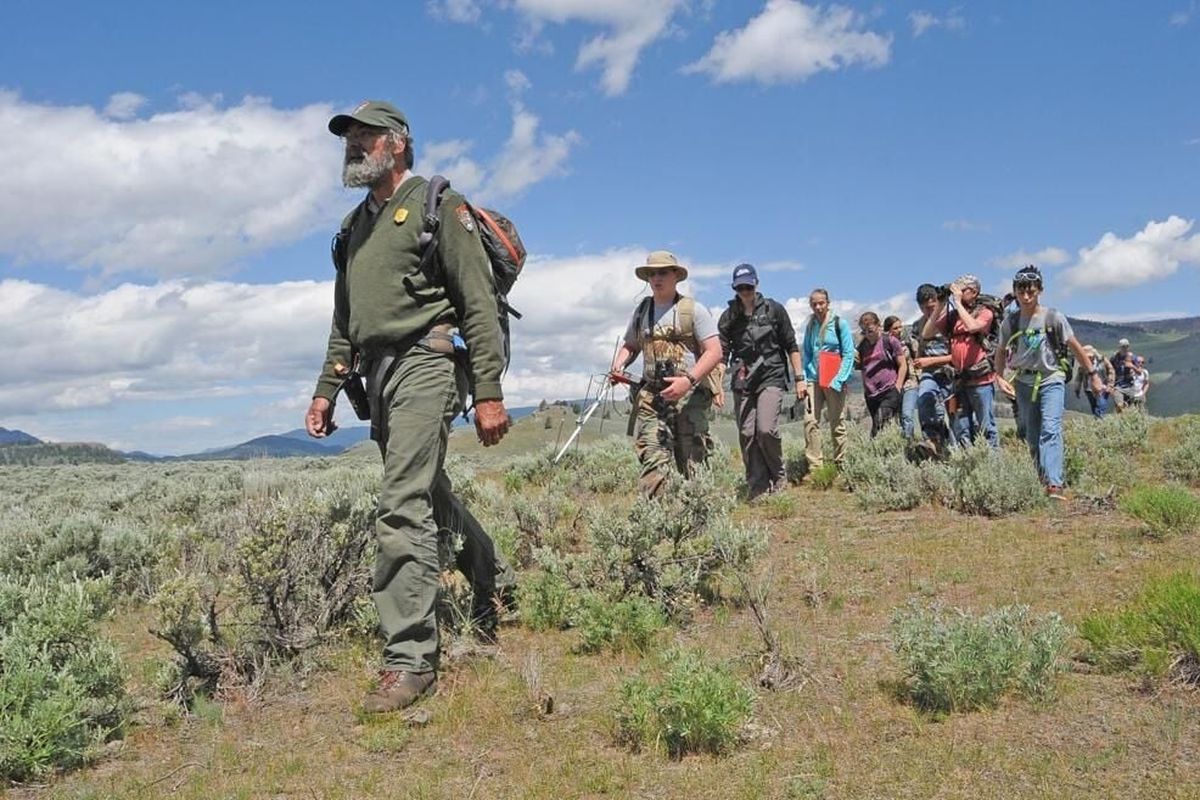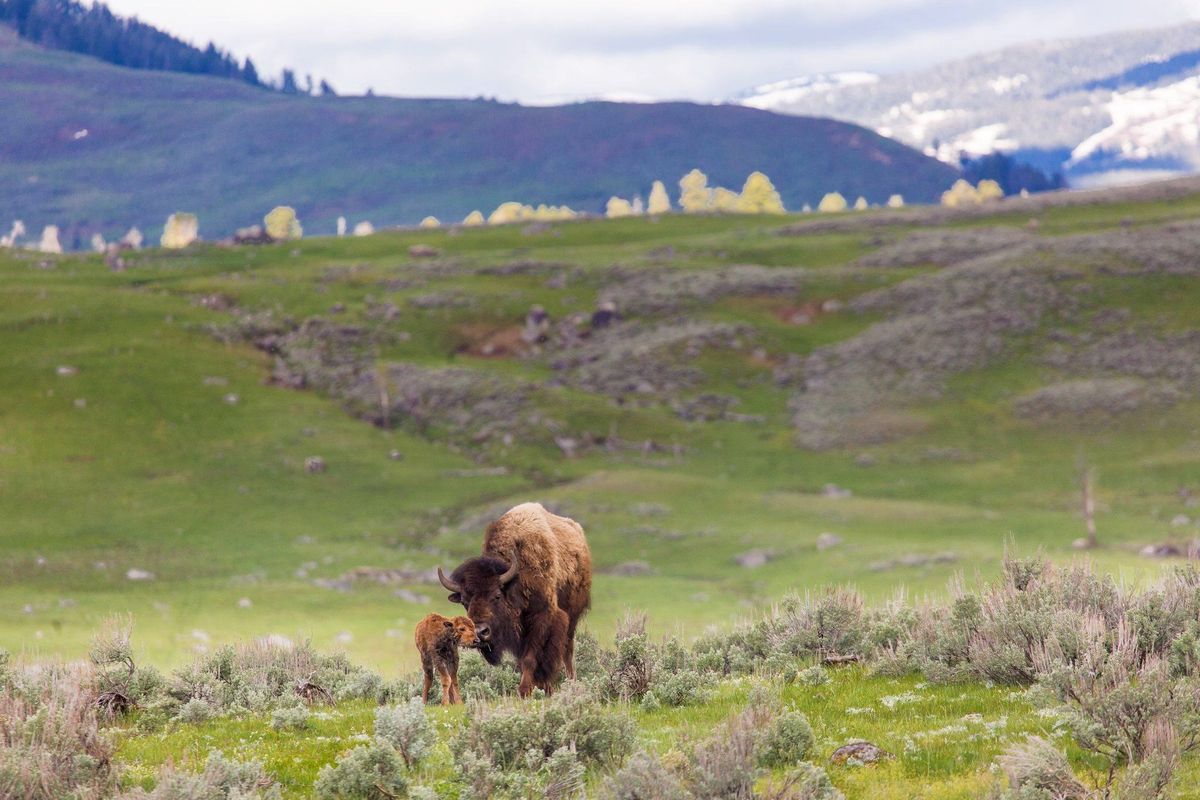Former Yellowstone bison program leader calls for expanded bison tolerance outside park
Rick Wallen leads a group on a hike. Wallen led Yellowstone National Park’s bison ecology program for 17 years before retiring six years ago. (Brett French/Billings Gazette)
BILLINGS – The next step in wild bison restoration is for the citizens of Montana to encourage Custer Gallatin National Forest officials to “realize their objective of more bison on forest lands,” according to Rick Wallen.
For 17 years, Wallen was the team leader of Yellowstone National Park’s bison ecology program. He retired six years ago and in early November spoke at a bison advocacy gathering in Bozeman where he outlined his vision for the future.
Right now, Wallen said his former employer has done all that it can to restore and preserve the big animals in Yellowstone.
“From my perspective, I think that you’re seeing what bison conservation will be like in the foreseeable future, unless we, as the citizens of Montana, collectively provide our state leadership with a vision for the a future that’s markedly different,” he said.
The next step, Wallen suggested, is assisted migration – trailering or somehow moving bison into habitat on forest lands.
Next step
This next step would allow bison more freedom to roam outside the confines of Yellowstone, like other wildlife, Wallen said. But such a move would require a shift by Montana’s political leaders who have in recent years been determined to limit bison migrations outside the park, citing concerns about the dangers they pose.
“It’s a very cutthroat atmosphere that arises regarding the wildness and conservation of the species, and it’s pitted against the livelihood of an industry and way of life,” Wallen said.
The most often cited fear is the possibility of spreading brucellosis, a disease that can cause pregnant cattle to abort. The state has no such restriction on the movement of elk outside of Yellowstone, animals that also carry brucellosis and have repeatedly infected cattle in the southwestern corner of the state.
“Montana policy really appears like elk is good and bison is bad, and we’ve heard that for so long,” Wallen said.
Tolerance zones
Montana has allowed Yellowstone bison limited expansion into portions of the state just outside the park’s boundaries. These so-called “tolerance zones” are near the communities of Gardiner and West Yellowstone. Many of the people in and near these small towns have adapted to coexist with the large species, Wallen said, but it wasn’t always that way.
Montana used to use helicopters, four-wheelers and horsemen to haze bison back into the park, the Park Service also hazed bison in the Gardiner area. Expansion of the tolerance zones outside the park, in part by retiring some public land grazing allotments and purchasing a large easement in the Gardiner Basin, ended the annual hazing.
However, Gov. Greg Gianforte has threatened to remove these tolerance zones citing displeasure with the park’s newly minted bison management plan.
“When you talk to many of the people in state leadership, they refer to wild bison as park bison, when in reality they’re really a public trust resource,” Wallen said.
Forest plan
In its 2020 Land Management Plan, Custer Gallatin National Forest officials recognized the “great importance” of bison and the role of the agency given that its lands border Yellowstone where some bison migrate in winter. Under “desired conditions,” forest officials endorsed a bison presence year-round with “enough numbers and adequate distribution to support a self-sustaining population.”
“The plan is clear that the Forest Service will work to remove barriers within the agency’s control,” said Mary Erickson, retired supervisor of the forest, in an email. “This could include such things as habitat improvements, fence removal, and/or adjustments to livestock grazing permits.”
For the agency to act on its own, or in concert with Yellowstone however, is unlikely and would be politically fraught.
“To reach objectives, all of this will take time, negotiation and baby steps for sure,” Erickson said.
But some representatives of tribes with treaty rights to hunt Yellowstone bison have expressed disappointment that a more aggressive stance on moving bison beyond the park’s boundaries hasn’t been taken.
Bison advocates have also emphasized the need to expand bison habitat outside the park, especially to spread out tribal hunters that right now are concentrated at the park’s northern boundary, not far from nearby homes. A small area near Beatty Gulch, on the Custer Gallatin National Forest, has become a killing field with piles of bison offal attracting scavengers and predators.
Erickson and Wallen agree that social and political tolerance are the greatest obstacles to wild bison expansion into Montana.
“This requires taking the long view, realizing that incremental progress will take time,” Erickson said. “The Forest Service should continue to work with the state, tribes, Yellowstone National Park, communities and adjacent landowners to facilitate better distribution across the Gardiner Basin and assess ways for bison to reach the Taylor Fork. Over the longer term, areas beyond current tolerance zones, such as the Tom Miner Basin, should be evaluated.”
Wallen said politicians are caving to a minority of their constituents in not pushing for wild bison expansion.
“I do think that the key to responsible governance is to seek the greatest good for the greatest number of citizens, and I’m not seeing it happen right now,” he said.
‘Groundhog Day’
When he worked for the Park Service, Wallen had a poster from the movie “Groundhog Day,” in which the lead character is doomed to repeat the Pennsylvania event over and over again. Although his job often felt like the same thing over and over again, Wallen said some gains were made.
“Preserving wild bison is probably one of the hardest species to tackle, but I do think, instead of going around in circles and having the same day every day, I think that we as citizens of Montana need to be the change,” Wallen said. “Change up our approach in order to help the Gallatin National Forest realize their objective of more bison on forest lands.”
Wallen concluded his talk with a call to action.
“Let’s develop a citizen initiative to help Montana be responsible with our wildlife legacy,” he said. “Manage wild bison like we manage the rest of our wildlife population, so that we can be proud of the legacy we are protecting for the future.”



